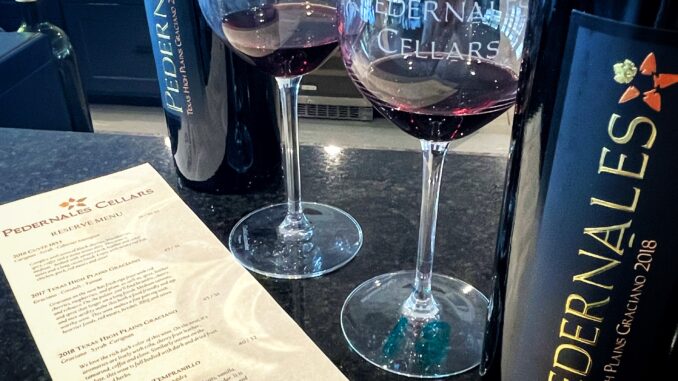
Graciano is a black-skinned wine grape from northern Spain, and if you know Rioja, it is one of the mysterious blending partners found in Tempranillo-based red wines. In fact, I think that it’s Graciano that elevates Tempranillo-based wine in Rioja and in the few other regions of the world like Texas where Graciano is grown and blended into these wines.
A classic Graciano wine, often hard to find, is deeply purple-colored and offers aromas of crushed blue-black or sometimes dark-red berries. But, best of all, Graciano also brings with it a smoky perfume of fine sweet Cavendish pipe tobacco. When combined with oak aging, the sweet tobacco elements intermingle ever so nicely with vanilla and spice. If you were a pipe smoker during your youth like I was in college when it was ”cool”, you might know that Cavendish tobacco refers to the treatment with heat, fire, steam and/or pressure that produces a sweet smoky taste and moist texture.

To me, this intense aroma component of Graciano is what makes it ever popular with winemakers in Rioja. When blended with Tempranillo, which gives you its red berry assault early in the tasting, the sweet smokiness of Graciano comes during the mid-palate of the wine following Tempranillo’s display. This is a great one-two punch and illustrates the power of blended wines.
During a visit to the Texas Hill Country winery Pedernales Cellars, I spied that they had a single varietal Graciano on their tasting list. In fact, they had two. Both were from grapes grown on the Texas High Plains, one from the 2017 vintage and the other from 2018. The 2017 Graciano was blended with a little Cinsault and Tannat, but was, in rough numbers, about 85% Graciano. The 2017 was blended a little more, this wine with Syrah and Carignan, yielding 75% Graciano as is necessary for a varietal-designated bottling.
Since it is rather rare to actually taste a varietal Graciano wine, both were very intriguing to mull through at the tasting bar at Pedernales Cellars. Of the two, the 2017 Graciano piqued my interest a little more because of its higher percentage Graciano and, from tasting, it appeared ready to show now. By comparison, the 2018 Graciano was somewhat more reserved on the nose and palate, but would likely gain by another year or two of bottle age.
Graciano has other qualities that are at play in Tempranillo blends, too. Graciano characteristically has low yields and ripens much slower than Tempranillo. This can be used to advantage in Tempranillo winemaking. Tempranillo ripens early and often suffers from elevated pH (loss of acidity) during the process of ripening on the vine. By comparison, Granciano’s slower ripening and tendency for lower pH (higher acidity) can be used to reduce the pH of the resultant blend. As needed, this can make a more exciting, vibrant and food-friendly wines with more refreshing acidity.

If you want to understand Tempranillo blends and, in particular those of the classic Rioja region of Spain and those in Texas made with an addition of Graciano, make a point to try a varietal Graciano wine like these at Pedernales Cellars. Another Graciano tasting suggestion is to try another favorite of mine, Spicewood Vineyards Good Guy red blend featuring Tempranillo with 18% Graciano, along with Cabernet Sauvignon and Merlot.
To visit Pedernales Cellars, see details below or click here to go to the winery website.
2916 Upper Albert Road
Stonewall, Texas 78671
T (830) 644-2037
F (830) 644-2034
Email: tastingroom@pedernalescellars.com
Photo credit: VintageTexas.com

Be the first to comment